Coconut palms, golden sand beaches, turquoise waters and…feral pigs?
Welcome to the wonderful world of upcountry Maui, where the wildlife is indeed quite wild.
Known amongst Hawaiians as pua’a, the Polynesian pig is both an epic sign of Hawaii’s diverse wildlife and an epic threat to the islands’ exquisite forests.
A very big Mahalo to Haleakala Bike Company for sharing this interesting article.
The pigs commonly seen today are descendants of those who first roamed the islands with the ancient Polynesians, who shuttled them to shore around 1000 AD.
Captain James Cook landed in the Hawaiian Islands in 1778 and introduced natives to things that had yet to find their way to Hawaii’s isolated beaches. With him came several animal species, including pigs, which have been assimilated into the current population, creating the hybrid species we see today.
Pua’a are now considered to be one of the earliest non-native species to arrive in Hawaii. It wasn’t until the early to mid-1800s that they became feral and began to survive off of the fruit and plants found in the various regions of the islands. From there, the population got out of control. (No surprise there: pigs and their offspring can produce a whopping 15,000 pigs over the course of five years.)
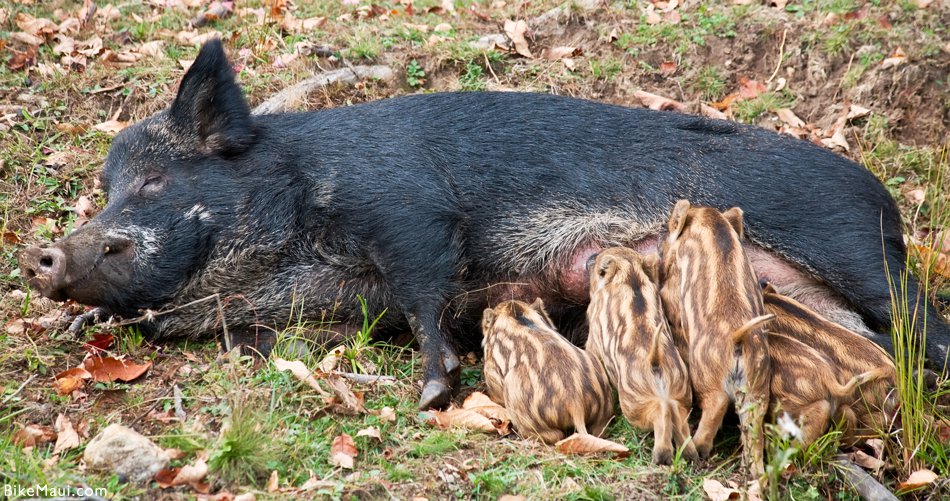
Now found on all of the major islands except Lanai—where the last feral pig on the pre-Ellison island was shot in 1930—puaʻa are seen from sea to sky but tend to wander most frequently in the islands’ wet rainforests and wide, open pastures, where there’s a greater abundance of shrubbery to forage.
True to their rowdy roots, the puaʻa has done acute damage to several native species of Hawaii. With hooves made for stomping, the Polynesian pig is known to trample through native vegetation and spread invasive fauna and flora—a critical issue for Hawaii’s fragile rainforests, which have seen a 50% decline in forestation in the last thirty years, in part because of the pua’a’s impact on plant life.

Don’t blame the creature: feral pigs possess naturally destructive habits that inadvertently alter the structure of rainforest floors.
They eat widely and hungrily, decimating lush understory vegetation in their search for earthworms, to the point that forests’ foundations give way to the proliferation of non-indigenous species. Banana poka (a species of passionfruit) and guava have taken over the native ohia and koa. Pigs also engender erosion, considering that their cloven hooves create wells in the earth that lead to further destruction.
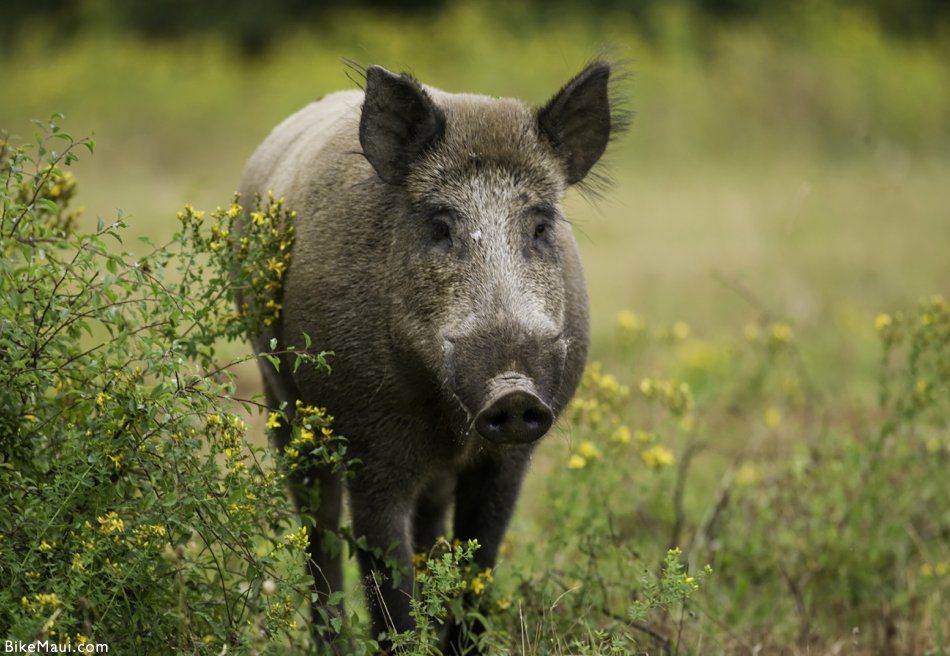
Indeed, other than land development, feral pigs are considered to be the largest precursor to deforestation—even more so than other exploitative species like mongooses, feral goats, birds, and sheep.
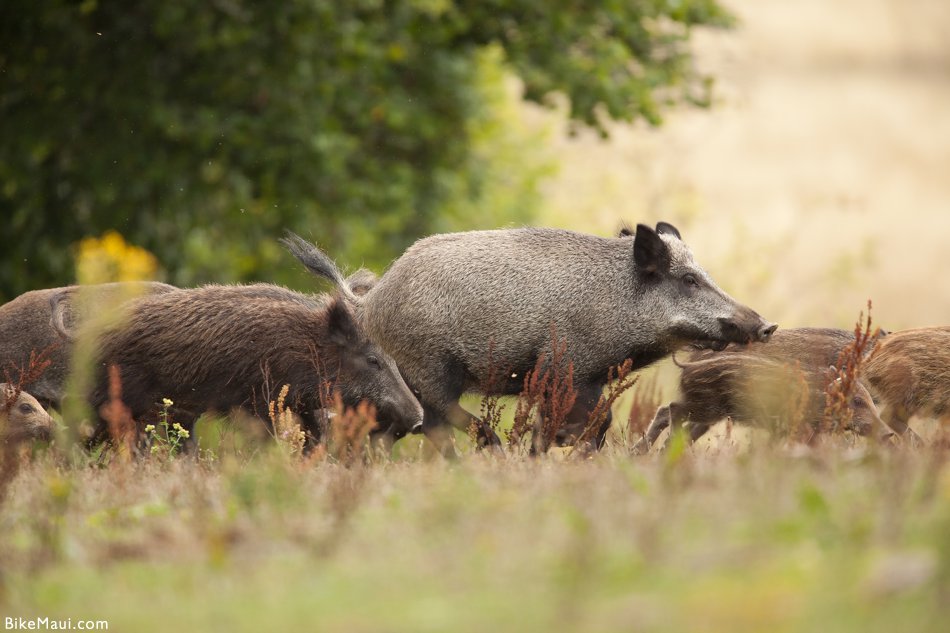
Efforts to eradicate wild swine have been in place since the early 1900s, rendering the Polynesian pig one of the few local animals that hunters are encouraged to capture.
Contemporary local hunters use what they deem a “hog call,” in which a tube with a reed creates a soft grunt; this is then followed by smacking the lips—a chomping noise that attracts the ever-ravenous pig to the area. In an effort of monumental proportions, 170,000 feral pigs were killed statewide between 1900 and 1958, and Haleakala National Park has spent an estimated $5 million on protecting its gems from the pua’a.
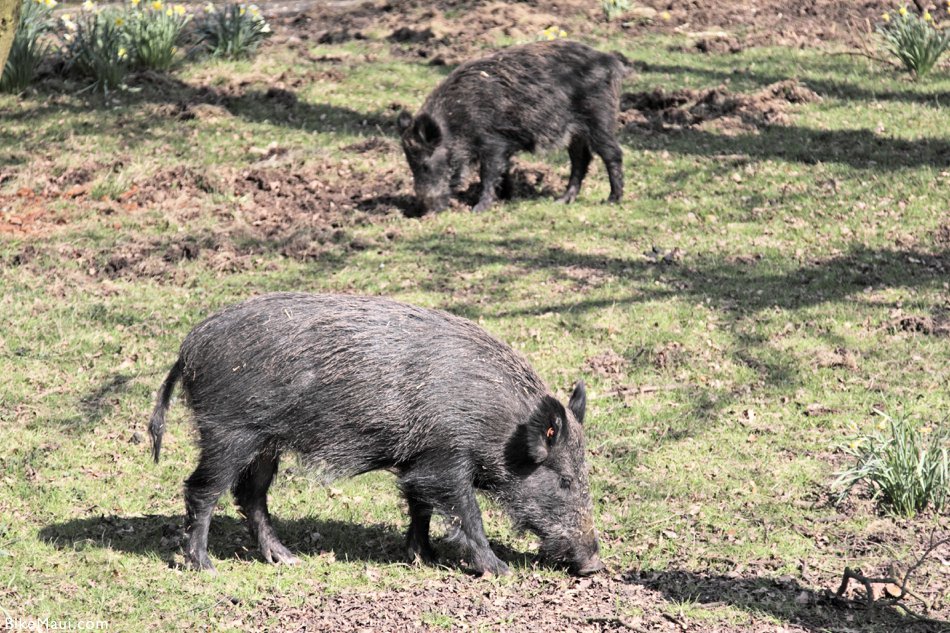
Hawaii isn’t alone in the feral pig dilemma: Australia considers them the biggest threat to their local agriculture.
And while local predators like bobcats and coyotes in California and Arizona may go after piglets, they don’t stand a chance of competing with mature boars—which can grow up to three times larger.
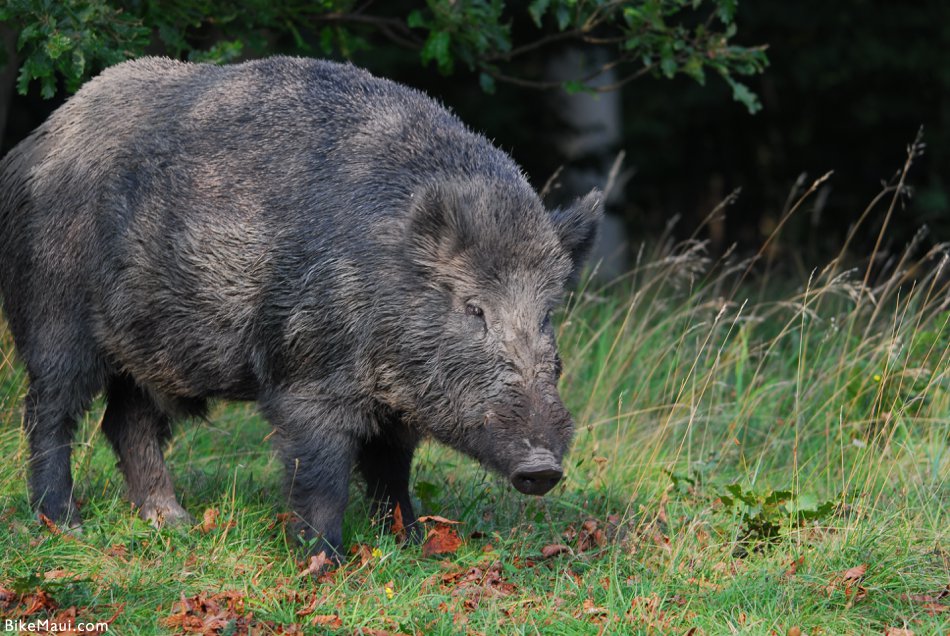
Commonly found in herds that are also known as “sounders of swine” and a “passel of hogs,” tourists can engage in hunting swine with the assistance of a professional pig hunter, who, while rare, still exist as relics from the plantation days, when hunting was less of a novelty than a complete necessity.
Puaʻa is an affectionate breed: Hawaiian swine breeds year-round, with piglets able to reproduce before making a full journey around the sun.
Pregnancy times average 113 days—or just shy of four months—with litters averaging seven piglets per push.
Hiking in Hana or biking in Makawao?
Don’t be surprised to hear the (feral) call of the wild: In a survey conducted in 2008, a record number of feral pigs were found on the Eastern slopes of Maui, one theory being that a horde escaped a West Maui farm in the 1960s.
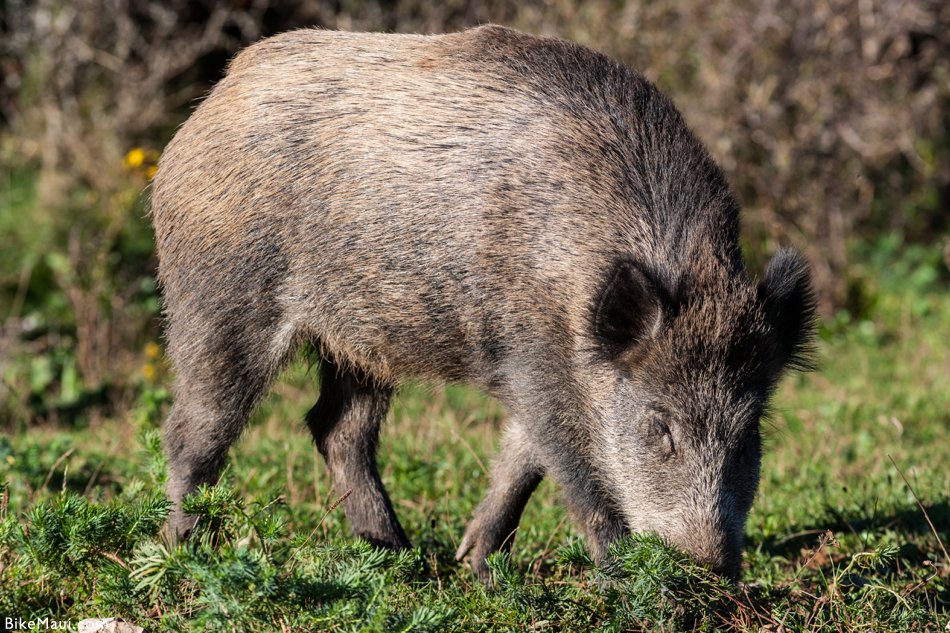
And should they end up becoming extinct in Hawaii, know that they’ll live on in mythology:
Hawaiian lore tells the story of the Kamapuaʻa, a bastard son born to Hina (also the mother to the demigod Maui). When Kamapua’a was born, his father, aware of Hina’s affair with his brother, disowned him and called him “Hog-Child.” In a twist of fate, “Hog-Child” grew to be handsome and brawny with shape-shifting abilities, but, drunk on a combination of his own charm and his ruthless desire to win his dad’s acceptance, tattooed his face, cloaked himself in animal skins, and murdered Hina’s husband. When his real father—Hina’s lover—claimed he had no son, Kamapua’a pillaged the villages, seduced women, and indiscriminately killed those who crossed him.
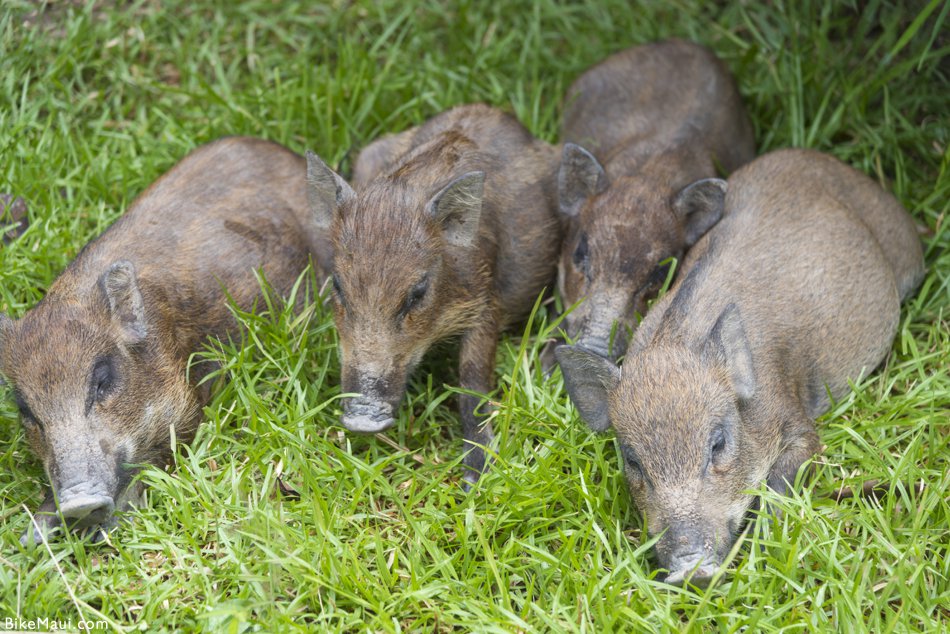
But after falling in love with Pele—the goddess of fire—his anger vanished, leaving him as attractive as he was when he was a child. The sudden transformation enraged the powerful goddess, who saw it as competition but in an act of mercy, gave him the wetter side of the Big Island. When Mount Kilauea erupted, Kamapua’a took to the seas to save himself—and to save himself from a broken heart, thinking his beloved Pele had perished under the lava. The ocean embraced the volatile “Hog-Child,” where he became humuhumunukunukuapuaʻa, or Hawaii’s State Fish; local children today are taught that the fish makes snorting sounds much like a pig. Consider the devastating story of Kamapuaʻa part of the islands’ draw for honeymooners: from his place in the ocean, he’s rumored to shield hearts from breaking.
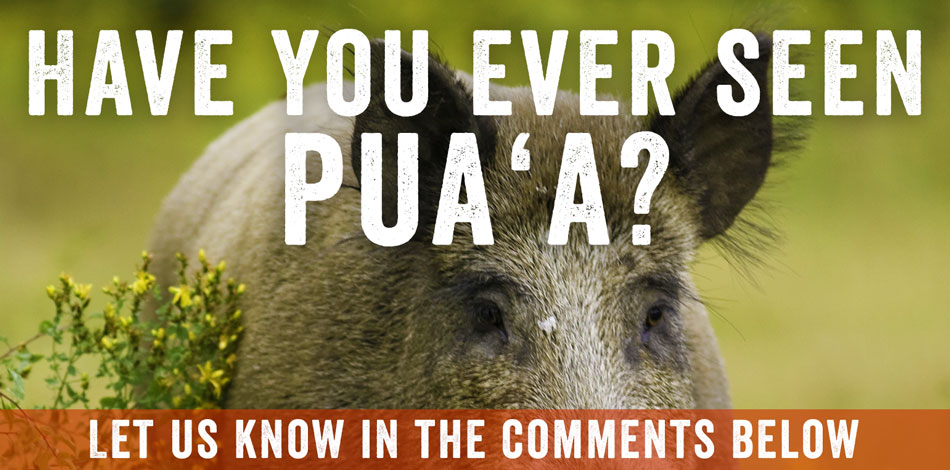
Photos courtesy of Photographers in Hawaii.

Born and raised on Maui, I have a deep love for language and writing. At present, I work as a content writer at Hawaii Web Group, where I have the opportunity to showcase my passion for storytelling. Being a part of Hawaiian culture, storytelling holds a special place, and I am thrilled to be able to share the tales of the amazing people, beautiful locations, and fascinating customs that make Maui such an incredible place to call home.

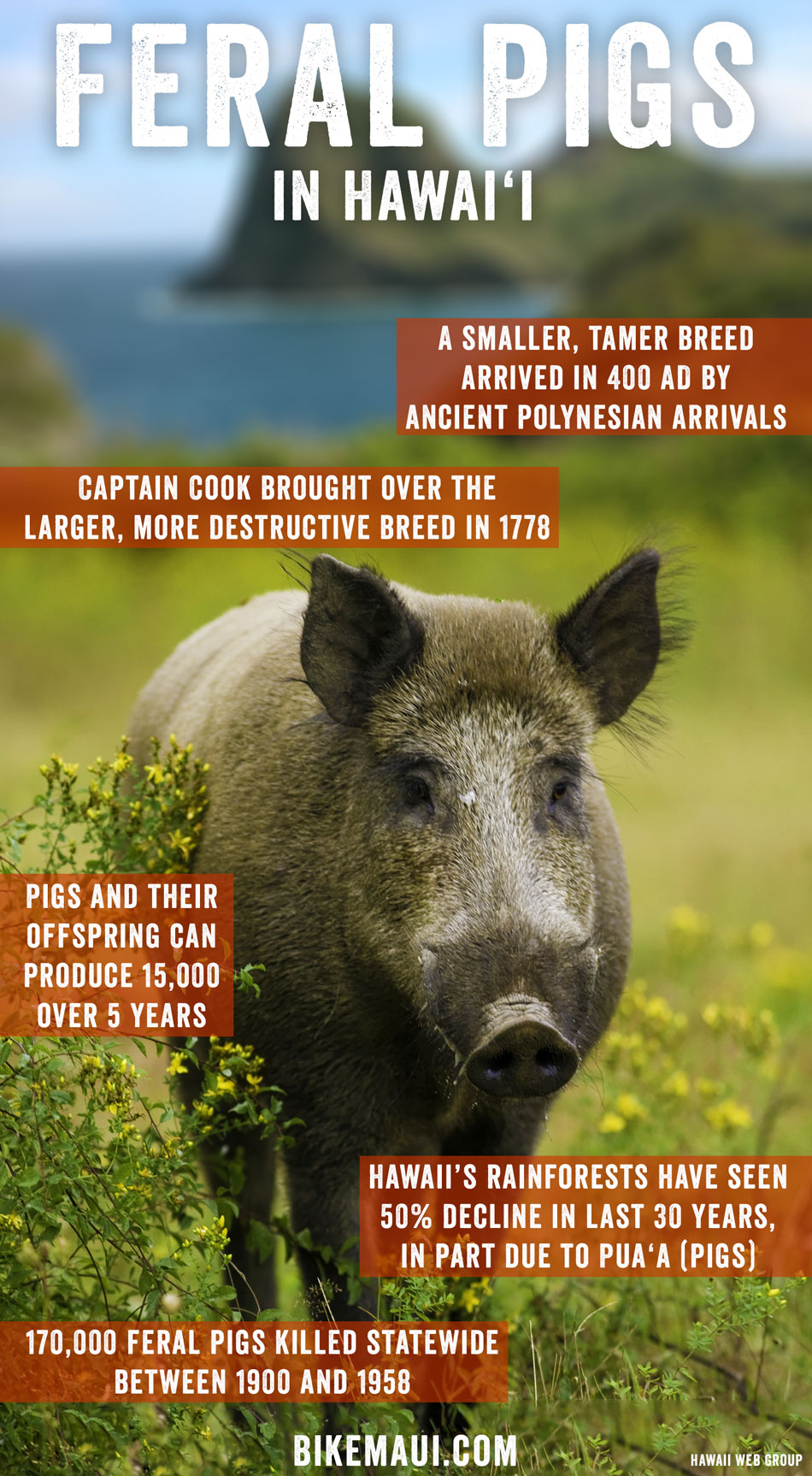
Beautiful page. But where do I start? …I guess at the top.
Feral pigs on Maui might not even have any polynesian pig in them since they may have originated as late as 1915, and if calculated rate of spread of 1/4 mile per year (as being the conservative estimate observed in the invasion of Kipahulu valley) feral pigs may have originated in Keanae (noted by Diong 1981) as early 1895 in Keanae. Another source originated in the 1940s in Coastal Kipahulu. I have also heard the theory of pigs escaping from a west Maui farm in the 1960s, but upon investigation, I cannot find any source for that and other sources are telling me that workers of Maui Land And Pine translocated east Maui Pigs to ML&P lands in West Maui for hunting. Translocation for hunting is both a common route for pigs to get introduced and also, back in that era, it was considered beneficial.
Captain Cook may have dropped off a couple of pigs of English breed off on Niihau, but it is erroneous to attribute the larger breeds to him since uncounted introductions followed. Tomich got it wrong about Polynesian pigs being small. Cook (or rather King after cook died) describes pigs up to 168 lbs in Kealakekua Bay. The wild pigs of today are about the size of the polynesian pig, and also, not much different in average size than the feral hogs of the US. True, the English breed of pig, and other breeds, were more efficient and grew larger, faster. But the Polynesian pig was not feral by the time cook arrived. It also wasn’t introduced in 400 AD, but rather was introduced about 1000 AD, and again, did not quickly go feral. The earliest evidence I can find of feral pigs is specific locations in the 1840s, 50s, and 60s which they apparently spread out from, merging with new populations until they occupied the whole islands (although some places to this day have not been colonized).
Lanai’s feral pigs were in fact eradicated by the 1930s, however, they were only established in 1911 when a hog farm enterprise went out of business and they let the pigs roam free.
As far as the polynesian pig being “smaller, tamer, and less damaging to their adopted environs” this appears to also be untrue, since the Mauna kea pig population, first noted in the saddle region in the late 1840s, was supposed to be the polynesian pig. It weighs the same, or maybe just 10 lbs less on average, is just as damaging, and is just as tame or prone to fertilization as any other pig. It is also said to be an early domestication of the southeast asian wild boar, which it reverted back to in form. Therefore the Mauna kea pigs (the polynesian pig) are said to resemble the Eurasian Wild Boar. At least Kauai, Oahu, and Molokai may also have genes from these pigs, as noted by a recent study. Maui was not analyzed.
Lastly, I am very curious as to whether those pigs pictured are on Maui? Because they so resemble Eurasian wild boar morphology and only a few of them look like Hawaii’s pigs.
Thank you so much for adding all this fascinating history! You’ve been a wealth of knowledge and we appreciate insightful, well-informed comments like this!
I heard a loud, close snort/growl on the redwood trail, upcountry/haleakela maui, at 6000 feet at 9am yesterday. I took that as a warning and I got the hell out of there.
A Hawaii Tribune Herald article, written in 2016, reported that a DNA study of 57 Hawaii feral pigs were found to be almost certainly direct descendants of pigs brought by the Polynesians 800 years ago. A study by Texas A&M, University of Hawaii, and Several other universities, presented proof the ancestry of feral hogs in Hawaii can be traced back to Polynesian. Perhaps they belong here just as much as humans.
It should also be acknowledged that wild pigs in Hawaii provide a wonderful local, organic food resource. In my circles, we often enjoy wild caught pork at the food table. It can be tough, but pressure cooked with rock salt, smoke sauce, coconut cream, and tea leaf, it makes awesome pulled pork. With food so expensive, and dependency on imported food vicarious, surely the pig populations can be managed to keep impact in balance.